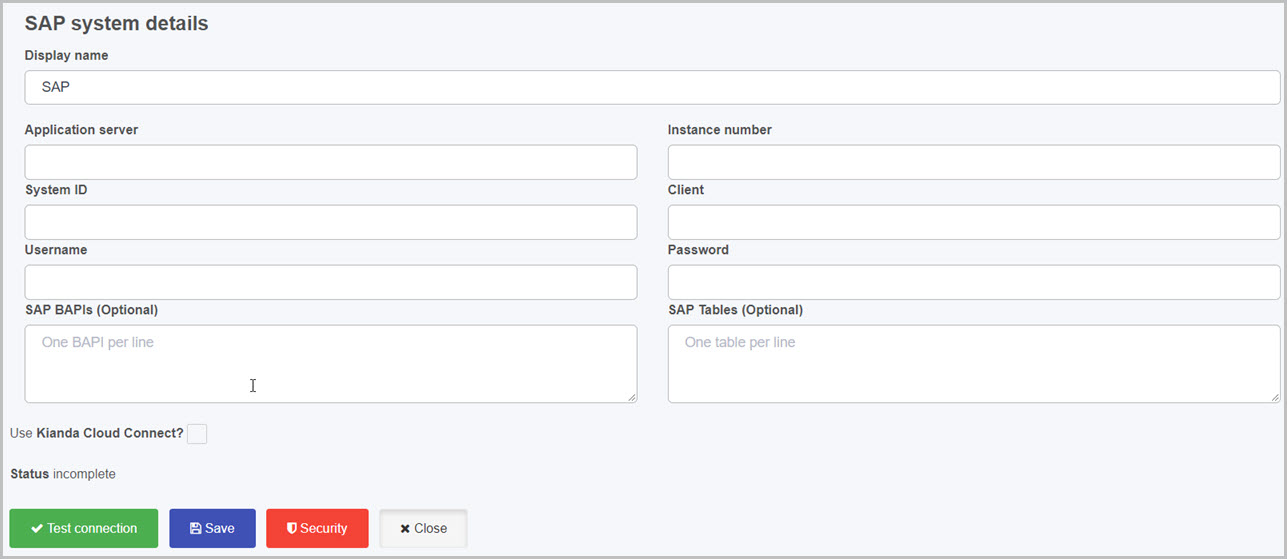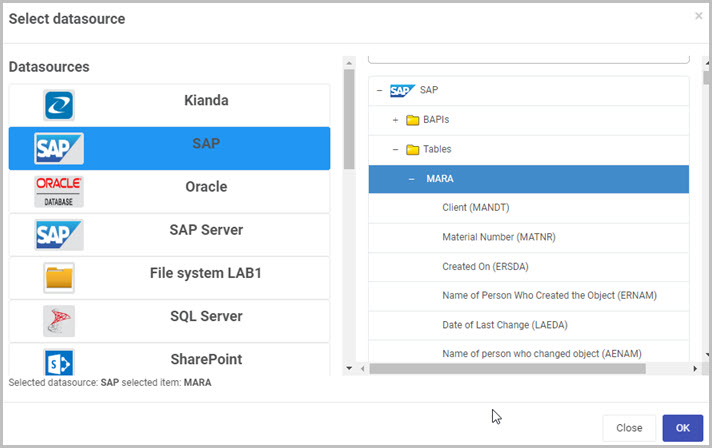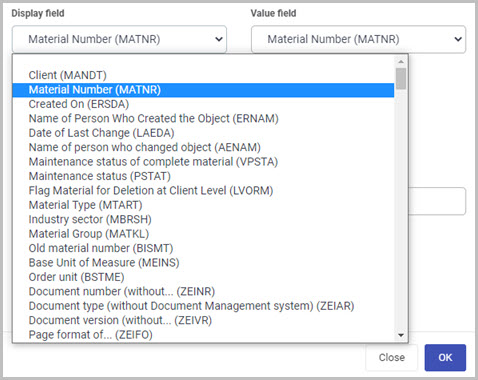SAP connector
One of the datasources available in Kianda is a SAP datasource. SAP is an enterprise resource planning software which allows you centralises data between all areas of your business and manage them in one SAP system.
Data in the SAP system are represented with schemas and tables. Each schema represents an area of your business and tables represent data within that business area. Using SAP as your datasource, you can perform Create, Read, Update and Delete (CRUD) operations on tables within your SAP system using the Data rules provided in the Kianda platform. When using the SAP connector, keep in mind that you can perform CRUD operations on data within a tables of the system, but you cannot perform CRUD operations on tables themselves, this mean are unable to create or delete tables.
SAP connector also has the ability to use Business Application Programming Interface (BAPI) functions through Kianda. This allows you to perform particular business tasks in your SAP system by calling BAPI functions using the Data rules provided.
When to use
You can use the SAP connector when you want access or modify data within a standard SAP or custom table in your SAP system. You can connect the SAP connector to a List field as its datasource, meaning you can access information from a table and display the information that is stored in the table. Take a standard SAP table MARA as an example, using this table you can display information on your Kianda forms using the data within the MARA table. You can also display information of your custom made tables within your SAP system.
Before getting started
You need to create a Kianda Cloud Connect connection with your device which will be used in the settings when filling out the SAP connector settings. To learn how to create a connection with you device using Kianda Cloud Connect, visit Kianda Cloud Connect.
How to get started
-
From the Kianda home page, click on Administration > Data sources.
-
Click on + Add new button
 and choose SAP from the list of datasources provided.
and choose SAP from the list of datasources provided. -
Fill out fields in the SAP system details screen.

Choose from the edit options:
-
Application server - enter in the IP address that your SAP system is run on.
-
Instance number - enter in the Instance number that you want to connect to from your SAP server.
-
System ID - enter in the ID of your SAP system. A system ID has three characters.
-
Client - enter in the Client your want to connect to from your SAP system.
-
Username - enter a username used to connect to your SAP system.
-
Password - enter in the password used to connect to your SAP system.
-
SAP BAPIs - enter in BAPI functions that you want access too when performing BAPI functionalities on your SAP system. Each BAPI must be on a separate line with no spaces, see image below:

-
SAP Tables - enter in SAP tables you want to have access to when performing CRUD operations from your SAP system. Each table must be on a separate line with no spaces, see image below:

-
Use Kianda Cloud Connect - by default this option is disabled, the cloud connect is used to create a connection between your local device and Kianda itself. To learn more about Kianda Cloud Connect and how to create a connection between Kianda and your PC, go to Kianda Cloud Connect. This option must be enabled to successfully establish a connection between a SAP system and Kianda.
- Connectors - displays all available connector PC’s that have a connection established with your Kianda subscription.
-
Status - represents the current status of the connection.
- incomplete - means that the details of the connector were not fully completed
- test failed - means that the details of the connector are incorrect and the connection has failed.
- ready - means that the connector has successfully connected and its ready to be used.
-
-
When you have added the SAP system details, you are ready to test your connection and add security. At the bottom of the SAP system details page, click on Test connection button
 and if the service has been correctly configured, then you should receive a notification saying Connection test succeeded.
and if the service has been correctly configured, then you should receive a notification saying Connection test succeeded. -
Click on Save
 to save the connection and you will receive a notification saying Details saved successfully.
to save the connection and you will receive a notification saying Details saved successfully. -
Add Security settings by clicking on the Security button, go to Setting security for data sources for more details.
-
Click on Close to close the details page and return to the data source management main view.
SAP Table parameters
When you use a SAP datasource, unlike some of the other data connectors in Kianda, SAP does not have default parameters. When you connect a SAP connector as your datasource, you can choose which Table or BAPI you want to use when performing CRUD operations. For example when connecting a SQL datasource to a List field and selecting a table you want to use, the parameters will depend on what data are present in the tables. Take standard SAP Table MARA as an example. We have an Employee table which we select when connecting a datasource to a List field, to learn how to a datasource to a list field go to List control, see image below:

The list of parameters displayed in the the Display field, Value field and Sort by field will match the columns that we have in the Employee table, see image below:

SAP BAPI functions
In order to use BAPI functions from your SAP system effectively, the Data rules within Kianda can be used. Data rules allow you to send data as well as receive it. For example if your BAPI function needs data when calling it, you can use any of the Data rules for example Create item rule to send data using the input mapping section or when receiving data you can use the on success mapping.
Take a BAPI function which retrieves a list from your SAP system as an example. You can use the on success mapping to store the list in a Kianda field. If for example this BAPI function takes an argument where you want to specify how many items from the list it retrieves, you can input that information in to the input mapping section of the data rules. To learn more about on success mapping go to On Success Mapping.
What’s next 
Your SAP system connector is now set up and ready to be used in your processes. To find out more about how to design processes go to Designer.
Feedback
Was this page helpful?
Glad to hear it! Please tell us how we can improve.
Sorry to hear that. Please tell us how we can improve.